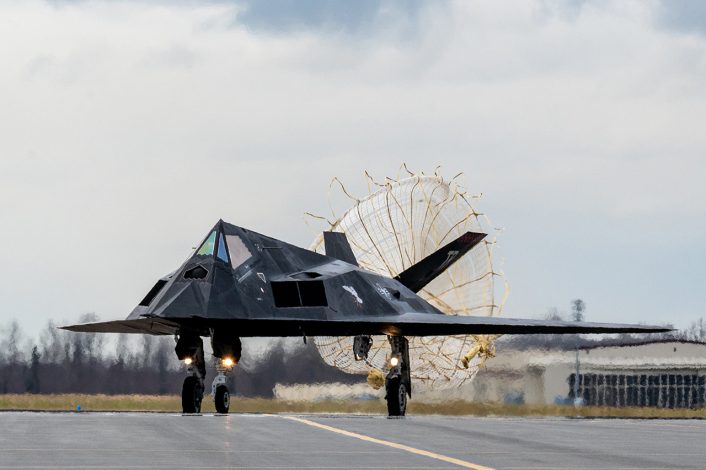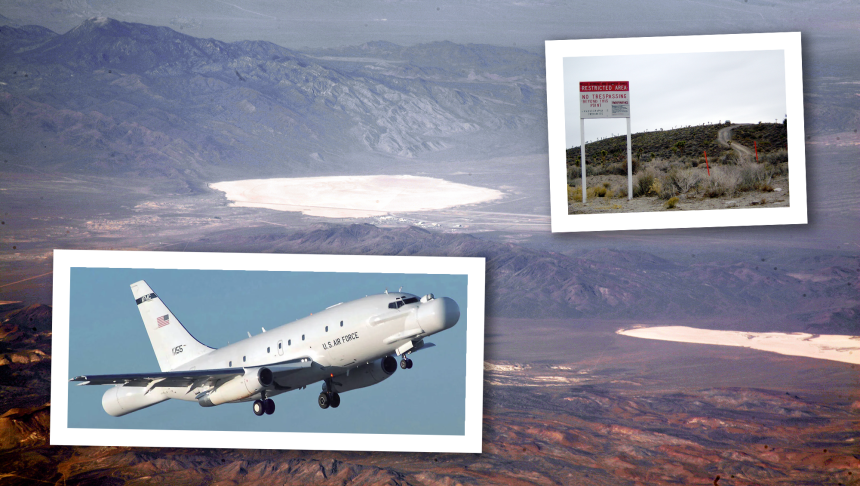Photographer Michał Rokita captured video of the elusive Boeing 737 from near Tikaboo Peak, the closest point where civilians can view the test facility at Groom Lake known worldwide as Area 51.
The footage, uploaded to Michał Rokita’s YouTube channel and discussed in a livestream by Rokita and Joerg Arnu of Dreamland Resort, shows 73-1155 departing Groom Lake in darkness for an early morning mission on Wednesday Aug. 13 before returning some hours later in daylight. The jet, a Boeing 737-200, or NT-43A in military parlance, performed several touch and goes prior to a full stop landing. Within minutes, the aircraft taxied to the base’s large Hangar 18, confirming not only that the aircraft operates from Groom Lake but even telling us from which building.
73-1155 is colloquially known as RAT or RATT 55 after its commonly used callsign, which reportedly stems from the term Radar Airborne Testbed as well as the aircraft’s serial number. On this sortie, RATT55 was transmitted from the aircraft’s transponder and was likely used on the radio during flight. However, when talking to controllers at Groom Lake the aircraft assumed an alternative callsign of SABRE98. Historically, using a different callsign when talking to Groom has been a fairly common practice, and until recent years it was the case that the ‘Janet’ worker transport flights would switch to a new callsign upon entering the base’s airspace.
Two new radomes are apparent on the aircraft’s fuselage compared to other recent imagery, suggesting new equipment has recently been installed. Fitted with advanced radar technology, RAT55 is thought to be used almost exclusively to evaluate the radar signatures of stealthy aircraft. This includes new designs and prototypes as well as existing platforms like the B-2 Spirit, which must have their stealth capabilities tested on a regular basis to ensure the aircraft’s radar cross-section readings are at their anticipated levels. With the ongoing development of no fewer than two flagship, manned stealth programmes – the Northrop Grumman B-21 Raider and the Boeing F-47 – in progress, demand for RATT55’s capabilities are sure to be high.
RAT55 working with a B2 #rat55 #b2 #ratt55 pic.twitter.com/mezwJKtJd8
— Julian Elnasser (@LAXSPOTTER97) May 28, 2025
Hangar 18’s mention is sure to pique the interest of many observers. While the Hangar 18 of the well-known conspiracy theory (and subsequent movie) was located elsewhere, the association of both Hangar 18 and Area 51 to tales of alien encounters means any hangar at Groom Lake known by that name was bound to earn an almost mythical status. Coincidentally, the Hangar 18 that exists at Groom Lake is in fact quite notable itself. It was, from its construction in the 1980s until the mid 2000s, the largest hangar on site, with its huge door and towering height able to accommodate any known aircraft in the U.S. inventory. As a general purpose hangar, it has likely seen a number of uses through the years, perhaps even multiple uses simultaneously. It has been speculated that the hangar has been used to house a special ‘museum’ collection of classified aircraft that had been tested at Area 51.
Because of the aircraft’s mission, and its now apparently confirmed base, high quality images of RATT55 are somewhat uncommon and usually only appear when the jet makes trips outside of the Nevada Test and Training Range (NTTR). Though marked as a U.S. Air Force aircraft, specifically part of the Air Force Material Command, official comment regarding the aircraft is effectively non-existent.
The T-43 was previously a relatively common airframe in the U.S. military, serving as training aircraft and then in a limited capacity for executive transport, but the unique NT-43A is the only such example still in service. Other 737s in U.S. service are of the more modern 737 NG or ‘Next Generation’ family, even including those that operate as part of Area 51’s ‘Janet’ fleet. While replacement of this ageing airframe would seem overdue, the continued modifications to the jet suggest its time is not yet at an end.
Nighthawks Continue to Fly
Rokita was also able to note flights by several F-117A Nighthawks from Groom Lake during his spotting trip. The stealthy attack aircraft, officially retired from active service in 2008, have famously continued to be a common sight in the skies above Nevada and even further beyond. Initially operating without acknowledgement, the U.S. Air Force has more recently openly admitted to their continued use, noting their deployment for dissimilar combat training. Based on contract notices, the Nighthawks could continue to fly well into the next decade or even longer.
Usually, the remaining F-117s fly from their original home at Tonopah Test Range (TTR) Airport further to the northwest of Groom Lake. TTR housed the F-117s through their early years of service until the fleet’s move to Holloman Air Force Base, New Mexico, a few years after becoming a public programme. The Nevada base saw little activity until their return in 2008 after their official retirement, with ‘disposal’ plans calling for the aircraft to be placed into storage inside TTR’s existing array of dedicated hangars. It’s from these hangars that they fly today.

However, for the past few months TTR has been closed to aircraft operations due to significant runway works. It is unclear whether the F-117s noted by Rokita at Groom Lake operate from there permanently or whether they have simply been detached there while TTR is out of action.
The F-117s are likely supporting ongoing developments in the Next Generation Air Dominance (NGAD) programme, as Joerg Arnu notes their use of hangar facilities thought to be connected to that programme. This might include simply flying in an aggressor role, or providing airframes as surrogates for the development of new systems. Compared to using prototype aircraft for these tests, using the already well-known F-117 platform eliminates the risk of exposing new airframe designs to public eyes unnecessarily and allows for testing to be completed in the daytime or even on moonlit evenings. The known performance and characteristics of the F-117 could also assist in any evaluations of new technologies as it significantly reduces the number of variables involved.
As noted at the beginning of this article, this deep and fascinating research into operations at Groom Lake is undertaken by enthusiasts and often shared via the Dreamland Resort website, without whom’s work over the past two decades and more very little of this article, or any other relating to Area 51, would be possible.









